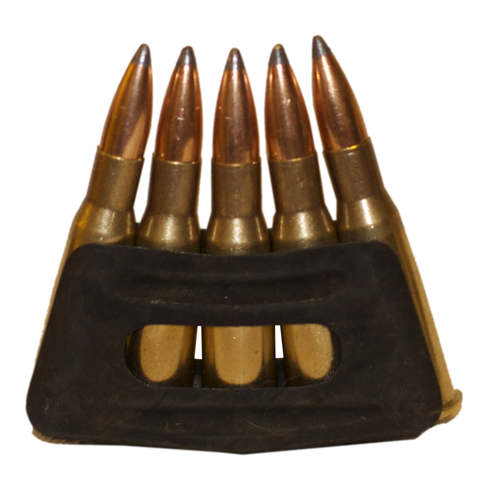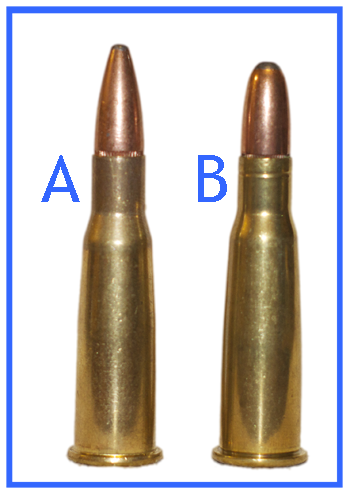 8x50Rmm "Lebel"
8x50Rmm "Lebel" 8x50Rmm "Lebel"
8x50Rmm "Lebel"The world's first smokeless powder cartridge.
| Article by Steve N. Jackson (v. 1) |
 The adoption of brass cartridge repeaters caused the French to themselves look for a way to leap ahead of their rivals. In the short run they adopted the Mle 1874 rifle based closely on the Mle 1866, which quickly brought them up to parity. Then they sought a new propellant to create a much better ammunition for their rifles.
The adoption of brass cartridge repeaters caused the French to themselves look for a way to leap ahead of their rivals. In the short run they adopted the Mle 1874 rifle based closely on the Mle 1866, which quickly brought them up to parity. Then they sought a new propellant to create a much better ammunition for their rifles.
Explosives researchers started working with cellulose nitrate when it was discovered that nitric acid could form an explosive compound when absorbed by plant fibers such as paper. The explosive formed, sometimes called flash paper (when nitric acid was infused in paper fibers), so unstable that it was useless outside of the laboratory, but it caused a great deal of continued interest because it had the potential of replacing gun powder, the oldest man-made explosive.
In the 1840s an accidental advance, bringing nitric acid into contact with cotton, led to the introduction of guncotton. This material was an improvement over flash paper, and had practical uses, but was still too dangerous for mass production. Experiments did try to marry it with cannons, where its gas production capacity and low cost showed it had potential, but it was still very dangerous to handle and quickly fell from use. It was soon found though that by careful control of the manufacture of guncotton, especially by washing and drying it in a multi-step process, it could be made significantly more stable. This material was then usable for explosives, but burned to fast and eratically for firearms use.
In 1884 French chemist Paul Marie Eugène Vieille, a graduate of France's École Polytechnique, developed a method of turning guncotton into a gelatin that could be rolled flat, dried, and broken up into uniform flakes similar to how gunpowder was made. This formula could be controlled for burning time based on uniform size of its particles, and the dried product was shelf stable and fairly safe to transport. This new "white powder" was three times more powerful than gunpowder (now called "black powder") and solved a major issue with developing repeating firearms, the smoke created by rapid fire guns.
The French had been following United States weapon testing since the 1860s, and had noted that U.S. big game hunters were using very powerful cartridges with muzzle velocities above 500 meters per second to achieve a flat trajectory for a 26 gram lead bullet. The flat trajectory was useful in achieving accuracy past 300 meters range, since at longer ranges with lesser rounds the arc of the bullet causes it to be negatively effected by wind in a way that is difficult to predict. Another problem with the extremely high velocity black powder rounds being used by the Americans was that the lead ammunition would melt in the barrel, causing the bullet to deform and take on a less than ideal shape, reducing accuracy. Highly qualified shooters taking as many variables into consideration could reduce these errors, but the average soldier was not able to reliably hit anything at greater than 300 meters with anything but volley fire.
 The French had several solutions for this. First, with the new powder, called Poudre 'B', a smaller diameter bullet could be fired at considerably higher muzzle velocity than could be achieved with the older rounds. This higher velocity round required a gliding metal surface to avoid deformation (later lead shells for high velocity rounds would use other metals such as antinomy to raise the melting point of lead) so the lead bullet was encased in brass, which glided well against a steel barrel but did not cause much more wear than lead.
The French had several solutions for this. First, with the new powder, called Poudre 'B', a smaller diameter bullet could be fired at considerably higher muzzle velocity than could be achieved with the older rounds. This higher velocity round required a gliding metal surface to avoid deformation (later lead shells for high velocity rounds would use other metals such as antinomy to raise the melting point of lead) so the lead bullet was encased in brass, which glided well against a steel barrel but did not cause much more wear than lead.
A final concern of the French was what to do with the 1 million Gras rifles currently on hand, firing the older 11x59mmR black powder rounds, along with the thousands of new Kropatschek rifles entering service, including the Navy's Fusil de Marine mle 1878, and the Army's Fusil d'Infanterie mle 1884 and mle 1885. The French wanted to retain these weapons for second line use, and testing indicated that they were all strong enough to handle the new smokeless powder.
The 8x50mmR was thus a compromise round created by necking down the older 11x59Rmm round in two stages (if it had only been necked down once the extra space in the case would have made ignition of the powder problematic). The base of the round fit the standard 11mm bolt-head and had the same head spacing, while the round was lighter and could be carried in greater numbers than the older round, allowing for an increase in real firepower. The first 8x50mmR was known as Balle M and clearly outmatched every competitor in the world. Its 15 gram bullet travelled at nearly 700 meters per second, and was effective for aimed fire at nealy 400 meters. A skilled marksman in ideal circumstances could hit a target at nearly three times that range, while volley fire was theoretically possible at nearly 1,800 meters.
 The 8mm Lebel round startled Europe. During the Franco-Prussian war a division of French soldiers using Chassepot rifles were able to shoot 40,000 rounds per minute, but were limited by the cloud of smoke they would create in doing so. Despite this, the Chassepot had killed tens of thousands of Germans in what was otherwise a war that the Germans had all the advantages. Now, armed with Lebels, the French outranged the German 11mm rifles and could fire five times as much ammunition with no smoke to interfere with their aim. Otto von Bismark was so disturbed by the French arming their soldiers with these rifles that he actively campaigned against antagonising the French during the Bulgarian crisis, for fear of bringing her soldiers and their smokeless powder into the field before the German army had time to equip with a new rifle.
The 8mm Lebel round startled Europe. During the Franco-Prussian war a division of French soldiers using Chassepot rifles were able to shoot 40,000 rounds per minute, but were limited by the cloud of smoke they would create in doing so. Despite this, the Chassepot had killed tens of thousands of Germans in what was otherwise a war that the Germans had all the advantages. Now, armed with Lebels, the French outranged the German 11mm rifles and could fire five times as much ammunition with no smoke to interfere with their aim. Otto von Bismark was so disturbed by the French arming their soldiers with these rifles that he actively campaigned against antagonising the French during the Bulgarian crisis, for fear of bringing her soldiers and their smokeless powder into the field before the German army had time to equip with a new rifle.
Oddly enough, as revolutionary as this round was, the 8x50mmR was never considered to be the final word in French armament. Almost immediately after fielding the round in the Mle 1886 rilfe, itself simply an updated Kropatschek Mle 1885, plans were in place to replace it with a newer, rimless rifle cartridge. At the same time development of a new bullet for the 8x50Rmm, the Balle D, was in progress, although this round would not reach standardization until 1898. The new replacement cartridge eventually emerged as the 7x57mm Meunier but was never developed due to disagreements in the general staff on tactics, and eventually, by the start of the Great War.
After the war the 8x50Rmm remained in front line use with plans to develop a new, modern ammunition. The new ammunition turned out to be the 7.5x58mm, eventually modified to 7.5x54mm. Despite the new ammunition, efforts were made to improve the 8x50Rmm to increase the rounds long range performance in heavy machine guns. The result was the Balle N round, the most modern of the various Lebel rounds. While designed for heavy machinegun use (specifically, Mle 1914 Hotchkiss machine guns), the Balle N was usable in rifles if they had a minor chamber modification made. As a result more than 1 million rifles from 1928 to 1939 were recalled and rearsenalled. To designate these weapons as safe for Balle N, a pair of N marking were placed on the weapon, one on the receiver, the second on the barrel.

The 8x50Rmm Lebel was kept in service from 1886 until the last Berthier carbine and Hotchkiss Mle 1914 machine guns were retired from reserve and Gendarme arsenals in the 1990s. As a result, the round was in service for more than 80 years, with front line service lasing nearly 50 years. Today the 8x50Rmm is rarely encountered. Although its ballistics make it an exellent hunting round, and at one time Great War veterans used tens of thousands of 8mm Lebel firing rifles, it is now extremely rare to find it in civilian hands in firing condition. Most 8mm Lebel rounds expended are blanks fired during reenactments.
Two sample hunting rounds for the 8x50mmR are shown above. The first (A) is a 12 gram soft point Balle N suitable for firing in later Berthier rifles but not useful for the MLE 1886 M93. The second (B) is an 11.75 gram soft point round nose loaded to the Balle D standard, intended for use in older, unmodified MLE 1886 M93 rifles. Neither is commercially loaded anymore, but reloading information and suitable bullets exist to make either case, and some professional reloading services make these cartridges.
| 8x50Rmm Lebel | |
| Bullet Diameter | 8.3mm |
| Rim Diameter | 13.8mm |
| Case Length | 51mm |
| Bullet Weight | 12.8gr |
| Muzzle Velocity | 730m/s |
| Muzzle Energy | 3,364 J |
| Citations |
Barnes, F. (2009). Cartridges of the World: A Complete and Illustrated Reference for Over 1500 Cartridges. Guns Digest Books. Edited by Bodison, H.
Ezell, E. (1983). Small Arms of the World. Stackpole Books.
Hogg, I. (1999). Greenhill Military Small Arms Databook. Greenhill Books.
Houn, J. (1983). Proud Promise: French Autoloading Rifles 1898-1979) by Jean Huon. Paris: Collector Grade Publications.
Houn, J. (1988). Military rifle and machine gun cartridges. Ironside International Publishers.
Langlois, H. (1903). Conséquences tactiques du progrès de l’armement. Imperial Military Library of Paris
Majendre, V. And Brown, C. (1974). Military Breech Loading Rifles: The Snider, the Martini-Henry and Boxer Ammunition. Arms & Armour Press.
Rigg, A. And Garvie, J. (1892). Modern Guns and Smokeless Powder. Cornell University Library. Reprint from Scan, 1992